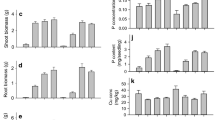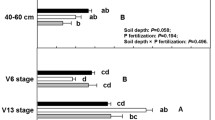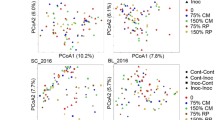Abstract
Phosphorus (P) can be low in soil under low input organic management; however, beneficial crop plant associations with arbuscular mycorrhizal fungi (AMF) are known to promote crop nutrition and increase phosphorus uptake. Thus, management strategies that promote AMF associations are particularly desirable for low-input cropping systems. The objectives of this study were to determine the impact of seeding rate on AMF colonization and the impact of AMF colonization on P concentration and uptake by organically grown field pea and lentil. Field experiments examined the impact of three seeding rates of field pea and lentil on P uptake and crop yield. Phosphorus accumulation was examined further in a controlled growth chamber experiment, in which field pea was sown at rates corresponding to those used in the field and harvested at 10-day intervals until 50 days after emergence. In the field, the level of AMF colonization of roots remained at 80% for field pea, while colonization of lentil increased with increasing seeding rates from 77% to 88%. The level of AMF colonization of field pea achieved in the growth chamber after 50 days was 80% for the two highest seeding rates and 60% for the low seeding rate. The rate at which AMF colonization occurred did not vary between treatments. Ultimately, AMF colonization level did not affect P accumulation. In contrast to several previous studies, both field and growth chamber experiments revealed that AMF colonization was not reduced at higher seeding rates. These results suggest that organic farmers may increase seeding rates without adversely affecting P nutrition.





Similar content being viewed by others
References
Abbott LK, Robson AD (1984) The effect of root density, inoculum placement and infectivity of inoculum on the development of vesicular-arbuscular mycorrhizas. New Phytol 97:285–299
Baird JM, Shirtliffe SJ, Walley F (2009a) Optimal seeding rate for organic production of lentil in the northern. Great Plains 89:1089–1097
Baird JM, Walley F, Shirtliffe SJ (2009b) Optimal seeding rate for organic production of field pea in the northern Great Plains 89:455–464
Barraclough PB (1989) Root growth, macro-nutrient uptake dynamic and soil fertility requirements of a high-yielding winter oilseed rape crop. Plant Soil 119:59–70
Corre-Hellou G, Crozat Y (2005) N2 fixation and N supply in organic pea (Pisum sativum L.) cropping systems as affected by weeds and peaweevil (Sitona lineatus L.). Eur J Agron 22:449–458
Entz MH, Guilford R, Gulden R (2001) Crop yield and soil nutrient status on 14 organic farms in the eastern portion of the northern great plains. Can J Plant Sci 81:351–354
Gahoonia TS, Ali O, Sarker A, Rahman MM, Erskine W (2005) Root traits, nutrient uptake, multi-location grain yield and benefit-cost ratio of two lentil (Lens culinaris, Medikus.) varieties. Plant Soil 272:153–161
Galvez L, Douds DD Jr, Drinkwater LE, Wagoner P (2001) Effect of tillage and farming system upon VAM fungus populations and mycorrhizas and nutrient uptake of maize. Plant Soil 228:299–308
Germida JJ, Walley FL (1996) Plant growth-promoting rhizobacteria alter rooting patterns and arbuscular mycorrhizal fungi colonization of field-grown spring wheat. Biol Fertil Soils 23:113–120
Giovannetti M, Mosse B (1980) An evaluation of techniques for measuring vesicular arbuscular mycorrhizal infection in roots. New Phytol 84:489–500
Gosling P, Shepherd M (2005) Long-term changes in soil fertility in organic arable farming systems in England, with particular reference to phosphorus and potassium. Agric Ecosys Environ 105:425–432
Gupta V, Satyanarayana T, Garg S (2000) General aspects of mycorrhiza. In: Mukerji K, Mukerji G, Chamola BP, Singh J (eds) Mycorrhizal biology. Plenum, New York
Harley JL, Smith SE (1983) Mycorrhizal symbiosis. Academic, London
Jakobsen I, Nielsen NE (1983) Vesicular-arbuscular mycorrhiza in field-grown crops. I. Mycorrhizal infection in cereals and peas at various times and soil depths. New Phytol 93:401–413
Johnston AM, Clayton GW, Lafond GP, Harker KN, Hogg TJ, Johnson EN, May WE, McConnell JT (2002) Field pea seeding management. Can J Plant Sci 82:639–644
Janos DP (2007) Plant responsiveness to mycorrhizas differs from dependence upon mycorrhizas. Mycorrhiza 17:75–91
Kahiluoto H, Ketoja E, Vestberg M (2009) Contribution of mycorrhiza to soil quality in contrasting cropping systems. Agric Ecosyst Environ 134:36–45
Koide RT, Dickie IA (2002) Effects of mycorrhizal fungi on plant populations. Plant Soil 244:307–312
Koske RE, Gemma JN (1989) A modified procedure for staining roots to detect VA mycorrhizas. Mycol Res 92:486–488
Kucey RMN, Bonetti R (1988) Effect of vesicular-arbuscular mycorrhizal fungi and captan on growth and N2 fixation by Rhizobium-inoculated field beans. Can J Soil Sci 68:143–149
Mäder P, Flieβbach A, Dubois D, Gunst L, Fried P, Niggli U (2002) Soil fertility and biodiversity in organic farming. Science 296:1694–1697
Malhi SS, Brandt SA, Ulrich D, Lemke R, Gill KS (2002) Accumulation and distribution of nitrate-nitrogen and extractable phosphorus in the soil profile under various alternative cropping systems. J Plant Nutr 25:2499–2520
Manitoba Agriculture (2004) Field pea—production and management. Accessed on http://www.gov.mb.ca/agriculture/crops/pulsecrops/bhe01s01.html. Accessed at 12 Oct 2005
Maynard DG, Kalra YP (1993) Nitrate and exchangeable ammonium nitrate. In: Carter MR (ed) Soil sampling and methods of analysis. Lewis, New York, pp 25–38
Mosse B, Stribley DP, LeTacon F (1981) Ecology of mycorrhizae and mycorrhizal fungi. In: Alexander M (ed) Advances in microbial ecology, vol 5. Plenum, New York
Nazarko OM, Van Acker RC, Entz MH, Schoofs A, Martens G (2003) Pesticide free production of field crops: Results of an off-farm pilot project. Agron J 95:1262–1273
Oberson A, Nanzer S, Bosshard C, Dubois D, Mäder P, Frossard E (2007) Symbiotic N2 fixation by soybean in organic and conventional cropping systems estimated by 15N dilution and 15N natural abundance. Plant Soil 290:69–83
Oehl F, Oberson A, Tagmann HU, Besson JM, Dubois D, Mäder P, Roth H-R, Frossard E (2002) Phosphorus budget and phosphorus availability in soils under organic and conventional farming. Nutr Cycl Agroecosyst 62:25–35
Ozanne PG (1980) Phosphate nutrition of plants-a general treatise. In: Khasawme FE (ed) The role of phosphorus in agriculture. American Society of Agronomy, Crop Science Society of America and Soil Science Society of America, Madison
Qian P, Schoenau JJ, Unger YL (1994) Simultaneous extraction of available phosphorus and potassium with a new soil test—a modification of Kelowna extraction. Comm Soil Sci Plant Anal 25:627–635
Richardson AE (2001) Prospects for using soil microorganisms to improve the acquisition of phosphorus by plants. Aust J Plant Physiol 28:897–906
Ryan MH, Angus JF (2003) Arbuscular mycorrhizae in wheat and field pea crops on a low P soil: increased Zn-uptake but no increase in P-uptake or yield. Plant Soil 250:225–239
SAS Institute (2004) SAS/STAT User’s Guide 91. SAS, Cary
Schroeder MS, Janos DP (2005) Plant growth, phosphorus nutrition, and root morphological responses to arbuscular mycorrhizas, phosphorus fertilization and intraspecific density. Mycorrhiza 15:203–216
Smith SE, Read DJ (1997) Mycorrhizal symbiosis, 2nd edn. Academic, London
Stockdale EA, Lampkin NH, Hovi M, Keatinge R, Lennartsson EKM, Macdonald DW, Padel S, Tattersall FH, Wolfe MS, Watson CA (2001) Agronomic and environmental implications of organic farming systems. Adv Agron 70:261–327
Thomas RL, Sheard RW, Moyer JR (1967) Comparison of conventional and automated procedures for nitrogen, phosphorus and potassium analysis of plant material using a single digestion. Agron J 59:240–243
Townley-Smith L, Wright AT (1994) Field pea cultivar and weed response to crop seed rate in western Canada. Can J Plant Sci 74:387–393
Vierheilig H, Coughlan AP, Wyss U, Piché Y (1998) Ink and vinegar, a simple staining technique for arbuscular-mycorrhizal fungi. Appl Environ Microbiol 64:5004–5007
Warner A, Mosse B (1983) Spread of vesicular-arbuscular mycorrhizal fungi between separate root systems. Trans Br Mycol Soc 80:353–354
Watson CA, Bengtsson H, Ebbesvik M, Loes A-K, Myrbeck A, Salomon E, Schroder J, Stockdale EA (2002) A review of farm-scale nutrient budgets for organic farms as a tool for management of soil fertility. Soil Use Manage 18:264–273
Acknowledgements
We thank Saskatchewan Pulse Growers for financial support, technicians at the University of Saskatchewan for technical support, and the reviewers and editor for their valuable comments on the manuscript.
Author information
Authors and Affiliations
Corresponding author
Rights and permissions
About this article
Cite this article
Baird, J.M., Walley, F.L. & Shirtliffe, S.J. Arbuscular mycorrhizal fungi colonization and phosphorus nutrition in organic field pea and lentil. Mycorrhiza 20, 541–549 (2010). https://doi.org/10.1007/s00572-010-0305-7
Received:
Accepted:
Published:
Issue Date:
DOI: https://doi.org/10.1007/s00572-010-0305-7




